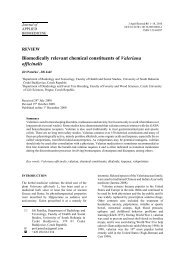Pharmacology and toxicology of absinthe
Pharmacology and toxicology of absinthe
Pharmacology and toxicology of absinthe
You also want an ePaper? Increase the reach of your titles
YUMPU automatically turns print PDFs into web optimized ePapers that Google loves.
<strong>Pharmacology</strong> <strong>and</strong> <strong>toxicology</strong> <strong>of</strong> <strong>absinthe</strong><br />
<strong>and</strong> protracted tonic/clonic convulsions that<br />
ultimately result in death or recovery. The only<br />
proven effect <strong>of</strong> thujone, however, is its toxicity to<br />
the brain. Thujone may play a role in <strong>absinthe</strong>, but<br />
the evidence is not conclusive. Finally, it should be<br />
noted that by focusing on one component <strong>of</strong><br />
wormwood oil, we ignore the many other poorly<br />
characterized compounds in wormwood <strong>and</strong><br />
<strong>absinthe</strong>'s other herbal ingredients which may play<br />
some role in <strong>absinthe</strong>'s intoxicating <strong>and</strong> toxic<br />
effects.<br />
Intraperitoneal administration <strong>of</strong> diazepam or<br />
phenobarbital 15 min before alpha-thujone at 100<br />
mg/kg results in almost all <strong>of</strong> the mice surviving<br />
this otherwise lethal dose. Ethanol i.p. pretreatment<br />
at 1 g/kg also protects against the lethal effects <strong>of</strong><br />
alpha-thujone at 100 mg/kg whereas a lower dose<br />
(0.5 g/kg) was ineffective. In experiments with<br />
Drosophila LC 50 12 mg/tube was estimated whereas<br />
on the Rdl-strain resistant to dieldrin LC 50 65<br />
mg/tube was obtained. This finding showed that<br />
Drosophila <strong>of</strong> the dieldrin-resistant (Rdl) strain are<br />
also resistant to alpha-thujone.<br />
Alpha-thujone modulates the GABA A receptor<br />
based on four observations. Comparison with<br />
picrotoxinin, the classical GABA A receptor<br />
antagonist, revealed similar poisoning signs <strong>and</strong> in<br />
both cases alleviation <strong>of</strong> toxicity by diazepam,<br />
phenobarbital, <strong>and</strong> ethanol (Kulkami et al. 1990,<br />
Enna et al. 1997). Most importantly,<br />
electrophysiological studies establish that in dorsal<br />
root ganglion neurons alpha-thujone is a reversible<br />
modulator <strong>of</strong> the GABA A receptor. Alpha-thujone is<br />
a competitive inhibitor <strong>of</strong><br />
ethynylbicycloorthobenzoate (EBOB) binding, i.e.,<br />
<strong>of</strong> the noncompetitive blocker site <strong>of</strong> the GABAgated<br />
chloride channel (Ratra et al. 2001).<br />
Absinthe <strong>and</strong> wormwood oil contain not only<br />
alpha-thujone as their purported active ingredient<br />
but also many other c<strong>and</strong>idate toxicants, including<br />
beta-thujone <strong>and</strong> ethanol in the case <strong>of</strong> <strong>absinthe</strong>,<br />
but alpha-thujone is the most common c<strong>and</strong>idate on<br />
the neurotoxicity principle. Beta-thujone is less<br />
toxic than alpha-thujone to mice (Rice <strong>and</strong> Wilson,<br />
1976) <strong>and</strong> Drosophila <strong>and</strong> in addition is 2.3-fold<br />
less potent in the [ 3 H]EBOB assay. Current low<br />
levels <strong>of</strong> alpha- <strong>and</strong> beta-thujone in <strong>absinthe</strong> are <strong>of</strong><br />
much less toxicological concern than the ethanol<br />
content (Strang et al. 1999). Another possibility<br />
exists that the toxic effect <strong>of</strong> thujone is realized by<br />
means <strong>of</strong> its metabolites. Alpha-thujone as other<br />
monoterpenes is easily metabolized.<br />
The single report on metabolism identifies<br />
thujol <strong>and</strong> neothujol probably as conjugates in the<br />
urine <strong>of</strong> thujone-treated rabbits (Ishida et al. 1989).<br />
Höld et al. (2001) found enzymatic reduction <strong>of</strong><br />
alpha-thujone to thujol <strong>and</strong> neothujol in low yield<br />
by rabbit but not mouse liver cytosol with NADPH.<br />
The mouse liver microsomal P450 system rapidly<br />
converts alpha-thujone to 7-hydroxy-alpha-thujone<br />
as the major metabolite <strong>and</strong> the diastereomers <strong>of</strong> 4-<br />
hydroxythujone <strong>and</strong> some other hydroxythujones as<br />
minor metabolites. The various hydroxythujones<br />
probably are not the terminal metabolites because<br />
they are expected to undergo conjugation <strong>and</strong><br />
excretion. However, the presence <strong>of</strong><br />
hydroxythujones in the brain suggests their<br />
potential importance in the neurotoxicity. From this<br />
point <strong>of</strong> view there are two principal c<strong>and</strong>idate<br />
toxicants: alpha-thujone <strong>and</strong> its 7-hydroxy<br />
metabolite. The 7-hydroxy compound was found in<br />
the brain at much higher levels than the parent<br />
alpha-thujone, suggesting possible conversion in<br />
situ, but this oxidation was not observed on<br />
incubation <strong>of</strong> alpha-thujone with brain microsomes<br />
<strong>and</strong> NADPH. Alpha-thujone compared with 7-<br />
hydroxy-alpha-thujone is 56-fold more potent in the<br />
[ 3 H]EBOB binding assay <strong>and</strong> much more toxic to<br />
mice <strong>and</strong> houseflies. It appears that all <strong>of</strong> the<br />
metabolites are detoxification products, i.e., less<br />
toxic than alpha-thujone. Importantly, alphathujone<br />
appears at much lower levels <strong>and</strong> is less<br />
persistent than 7-hydroxy-alpha-thujone. At<br />
severely toxic alpha-thujone doses (40–60 mg/kg)<br />
the levels in the brain at 30 min after<br />
administration <strong>of</strong> alpha-thujone were 0.3–1.0 ppm<br />
for alpha-thujone <strong>and</strong> 1.5–8.4 ppm for 7-hydroxyalpha-thujone<br />
with much higher levels (11 <strong>and</strong> 29<br />
ppm for alpha-thujone <strong>and</strong> 7-hydroxy-alphathujone,<br />
respectively) at 2.5 min when the<br />
poisoning signs are most intense. The minor<br />
hydroxythujone metabolites are detectable only up<br />
to 20 min after the 50 mg/kg alpha-thujone dose.<br />
The discovery <strong>of</strong> alpha-thujone <strong>and</strong> its metabolite<br />
in brain suggests that either one or both may<br />
contribute to the toxic manifestations.<br />
Unfortunately, the metabolism <strong>of</strong> alpha-thujone in<br />
humans is not known.<br />
CLINICAL COURSE<br />
Absinthe drinking caused both acute <strong>and</strong> chronic<br />
toxicity. The acute effect <strong>of</strong> <strong>absinthe</strong> came on<br />
rapidly after ingestion <strong>and</strong> evoked a cheerful mood,<br />
euphoria,a sharpened sense <strong>of</strong> perception, a sense<br />
<strong>of</strong> well being, followed by visual hallucinations,<br />
restlessness, giddiness, vomiting, vertigo, muscular<br />
disturbances <strong>and</strong> convulsions. Also angry<br />
excitement, impulsive violence <strong>and</strong> paranoia were<br />
very <strong>of</strong>ten observed. Serious <strong>absinthe</strong> poisoning is<br />
characterized by coma, respiratory arrest <strong>and</strong> death.<br />
Chronic effects <strong>of</strong> <strong>absinthe</strong> drinking include lack <strong>of</strong><br />
appetite, gastritis, repeated vomiting, progressive<br />
mental deterioration <strong>and</strong> disorder, psychosis,<br />
203





